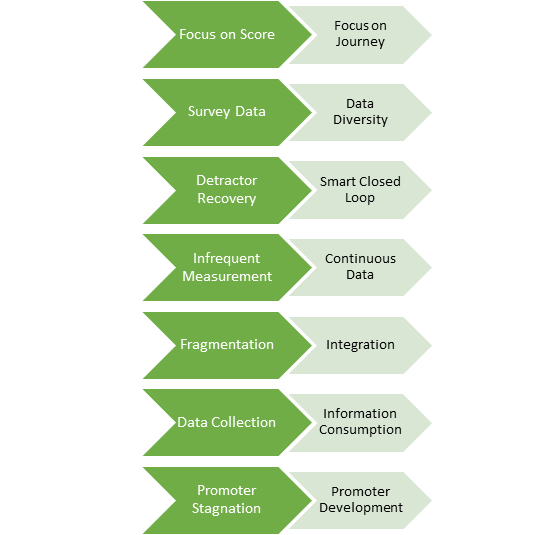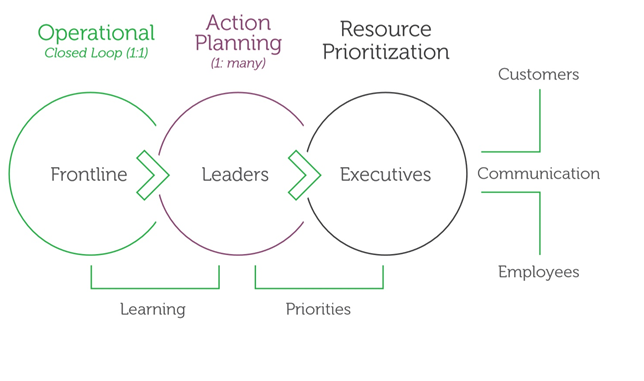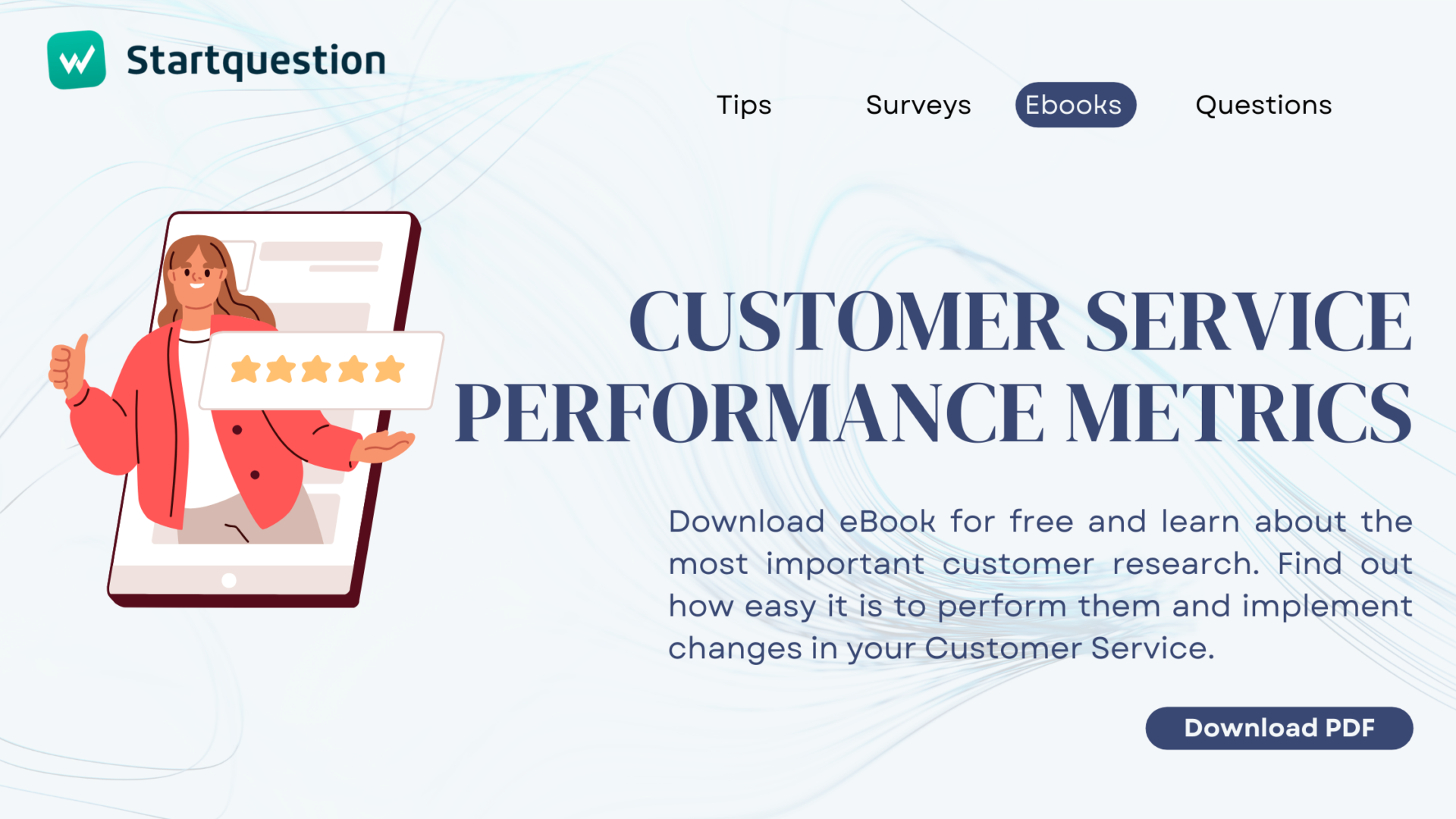Customer satisfaction is the buzzword of today’s marketing. Brands do their best to make their clients loyal. They go the extra mile to please them and keep them close. This seems to be the only effective way to stay on top of the business. A dissatisfied customer will eventually leave when he finds a better alternative to your service. You cannot afford poor service if you do not operate in the monopoly market. And even if you do, there is always a possibility that the industry situation changes, and then your competitors might carve a niche in your market share. For you, it means losing a significant number of clients. You can avoid it with the NPS methodology.
Startquestion is a survey software
Gather feedback via weblink, social media, email, and more.
No credit card required · Cancel any time · GDRP Compilant
If you do not want this scenario to become a reality, you should find a way to manage customer satisfaction and loyalty at every step of the customer journey. It is crucial to know what your clients love about your brand and what, in their opinion, should be improved. The best way to find it out is to simply ask them. However, when you handle a group of more than 10 clients, you should think of a more complex methodology that enables you to manage customer satisfaction. Net Promoter Score is a groundbreaking approach helping brands extend customer lifetime. However, this methodology has also evolved within the past years as the marketing landscape has been changing faster than ever.
This article will give you an insight into how Net Promoter works and how it evolved from NPS to NPS2 from a research-based, data-driven approach to an integrated and holistic one.
The power behind NPS — Why customer satisfaction is crucial in your business
Customer loyalty is a crucial factor that determines a company’s financial performance. It is directly linked to many benefits, such as increased market share, lower costs, or higher revenue. Therefore, more and more companies understand the power of loyalty and invest significant time and resources to estimate, manage and increase loyalty levels. The biggest challenge, though, is to employ the most accurate, effective, and at the same time, unsophisticated system for customer loyalty management. Years of groundbreaking research conducted by Frederick Reichheld, founder of the Loyalty practice at Bain & Company, in close consultation with Satmetrix brought a valuable methodology that not only enables to gauge customer loyalty precisely but also allows to predict future growth accurately.
NPS is based on one simple question that investigates how likely it is that a customer would recommend a brand to a friend. Response options for the loyalty questions are based on a 0–10 point rating scale, with 0 representing extremely negative and 10 representing extremely positive. Customers can be segmented into three categories depending on the response to the NPS question. Each group represents their loyalty level combined with purchase behavior:
- Promoters (ratings 9–10) — customers who were highly likely to recommend a company and exhibited the highest rates of purchase and referral behaviors,
- Passive (ratings 7–8) — customers who were somewhat likely to recommend a company and exhibited moderate rates of purchase and referral behaviors,
- Detractors (0–6) — customers who were less likely to recommend a company and exhibited the lowest rates of purchase and referral behaviors.
Net Promoter is quickly gaining widespread industry adoption as companies recognize its power that stems from the simplicity and universality of the methodology. NPS helps brands get actionable customer insights about what is working in the company and what should be improved and then deliver information to employees at all corporate levels. Finally, the information derived from the NPS question helps companies to directly reach out to customers who take the time to share their feedback. Employees are then able to solve problems reported by clients, which directly improves customer satisfaction and loyalty. The process is called closing the loop and is widely used in customer experience management.
Another advantage of Net Promoter Score is the possibility to find out about your company’s financial condition in the future. Subtracting the percentage of Detractors from the percentage of Promoters yields the Net Promoter Score, which can range from a low of -100 to a high of 100. This result demonstrates a very strong link to long-term corporate growth, as it incorporates both the growth achieved through positive referrals, as well as the lost potential for growth caused by the effects of negative word-of-mouth.
Ready-to-use examples of customer surveys
Net Promoter evolution — what’s different between NPS and NPS2
It has been over ten years since the Net Promoter methodology was introduced to the public. Since then the marketing landscape has changed significantly. Companies recognize the critical role that customer satisfaction plays in business success. They understand the value of positive word-of-mouth and notice descending importance of traditional marketing. These changes forced the Net Promoter methodology to switch from a research-based and data-driven approach into a holistic understanding of business functioning.
NPS2 has developed around three pillars that determined necessary changes in the methodology.
- Market dynamics — As mentioned before, the marketing landscape has evolved faster than ever. Purchase decisions today are heavily dependent on referrals and reviews. Social media is a never-ending source of information about products. Customers trust recommendations from their peers rather than expert’s advice. In response to these changes, businesses are increasingly recognizing the importance of incorporating a referral marketing program into their strategies. What is more, companies shift to subscription business models, focusing on customer lifetime value and providing the best customer experience.
- Best practice learning — Companies can constantly improve their service by collecting customer feedback. They get immediate information on what works and what does not, so employees at different corporate levels can handle upcoming issues.
- Thought leadership — Employees should be engaged in managing customer service. Companies should understand the significant role of supporters and engage them in promoting a brand with their referrals. Finally, putting the customer first at your business’s core helps companies achieve better results.
What has changed in the NPS methodology
Years of studies have helped researchers take the NPS to the next level, providing companies with a new, more holistic approach to customer satisfaction management. The core goal of Net Promoter remains the same: measure, manage, and improve customer loyalty. However, the elements of the metric have evolved to become more effective. What is different?

First of all, NPS2 does not focus solely on a score. Instead, it highlights the importance of the whole customer journey. Net Promoter Score reflects customers’ overall experience with a brand, so it should focus on the customer experience at every touchpoint. The metric has also evolved in terms of data sources. NPS2 is based on data from various sources, not only surveys, providing brands with a better understanding of customer experience. What is more, promoters are the most important group as they provide you with the biggest portion of revenues. Therefore, focusing solely on Detractors recovery is not a proper approach. NPS2 undermines the importance of engaging Promoters who can also help in new customer acquisition. Moreover, studying customer satisfaction and loyalty cannot be a one-time event. Research should be a daily habit in a business. NPS2 also joins fragmented information into one integrated system that gives a holistic understanding of customer experience. Finally, the new Net Promoter moves from a data collection approach towards a more actionable one, focused on data consumption.
Everything you need to know about the new generation NPS2 methodology
You already know what has changed in the new generation Net Promoter methodology, so
now it is time to get a closer look at how to apply it in your business to effectively manage customer satisfaction and loyalty. What you should do first is to analyze the customer journey as a whole. Try to understand the journey at every touchpoint (when a customer contacts your brand). Use your insights and combine them with relationship and transactional data. Relationship surveys provide you with information about what are the drivers of loyalty. However, you also need transactional measures to monitor performance. This will help you create an integrated view of customer satisfaction at each stage.
A survey is just an effective tool for collecting information from your clients, but the insights will be useless if you do not know what to do with this data. You need to learn how to drive actions based on actionable insights. What is important here, you should ensure that employees at all organizational levels know their roles and goals, so they can effectively manage customer satisfaction. In order to improve workflow, you should divide employees into three categories based on their roles in an organization: frontline, management, and executive.
- Frontline’s main goal is to increase retention. They are the ones who directly connect with your clients. They need to understand customer needs and reported problems. They are accountable for closing the loop or delegating it to other entities.
- Management’s role is to detect loyalty drivers, that is, factors that impact customer satisfaction and loyalty, in order to improve overall customer experience.
- Executives are responsible for profitable growth. Therefore, they need to understand the linkage between NPS and the company’s performance, predict trends, and develop strategies that help improve satisfaction and loyalty.
Smart Loops — Take closing the loop to the next level
Segmentation of your staff takes closed loops to the next level. In the initial Net Promoter methodology, they were focused on Detractor’s recovery. Smart loops go far beyond the traditional front-line closed-loop process, engaging Passives and Promoters to build stronger relationships. They will help you develop a network of active brand ambassadors and transform dissatisfied customers into supporters. All you need to do is engage employees at all three levels.

The first operational level involves your frontline. The customer provides feedback, and customer service is accountable for solving an issue. However, you can leverage this feedback to learn about the root causes and ways for overall improvement. Then, you should use the information to develop strong relationships with clients.
The second loop helps improve the end-to-end customer experience on the leadership level. At this organizational level, it is possible to get a bigger picture of customer satisfaction management as a whole and, consequently, find a way to integrate the process of closing the loop in all departments.
The last executive smart loop involves resource planning depending on your company’s Net Promoter distribution. At this level, you need to recognize crucial customer categories and focus on what matters most to clients. On top of that, it is crucial to develop a solid communication strategy between both your clients and employees.
Organizational adoption — Incorporate NPS2 in customer satisfaction management
The final step involves putting everything that you have read in this entry into practice. You need to build a strategy that is based on information consumption and distribution instead of focusing on surveys only. Make sure that all the organizational levels have access to crucial information that is necessary for them to manage and improve customer satisfaction and loyalty. Finally, integrate all the processes to create an integrated system for customer experience management. Ensure that employees at all departments know their roles and goals.
Conclusion
Net Promoter Score methodology is considered as one of the most effective ways to measure, manage, and improve customer satisfaction. It has been proved by years of research and appreciated by many companies across the world. Not only does it help you find out what customers think about your brand, but it also gives you an insight into the future financial condition of your company, as there is a direct linkage between NPS and corporate growth. Now, you are given a better tool for customer experience leadership that is more adjusted to today’s marketing landscape. With NPS2, you can take it to the next level, providing your customers with the best experience. Apply tips from this entry in your company and secure the future of your business.




